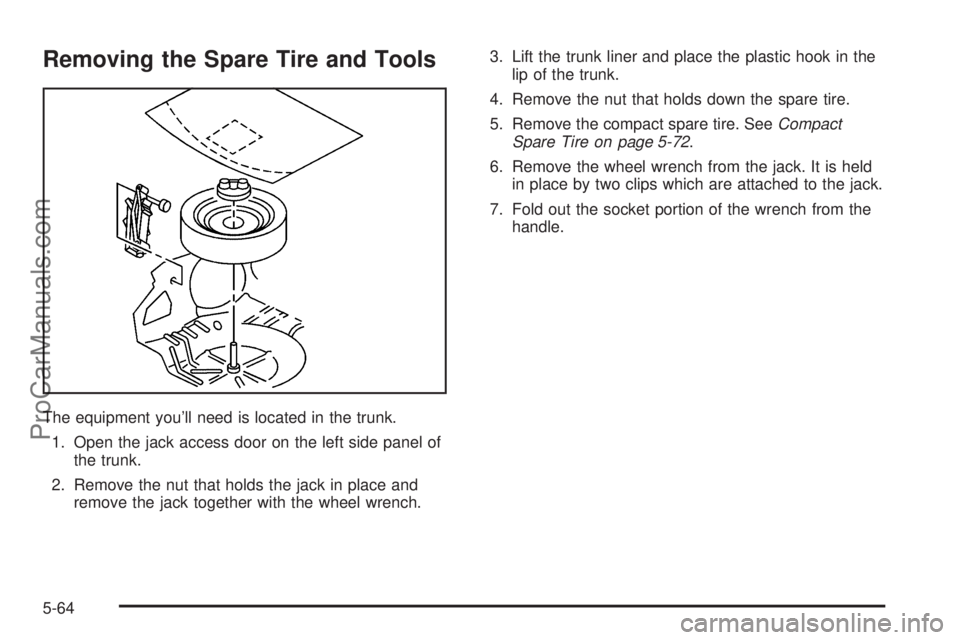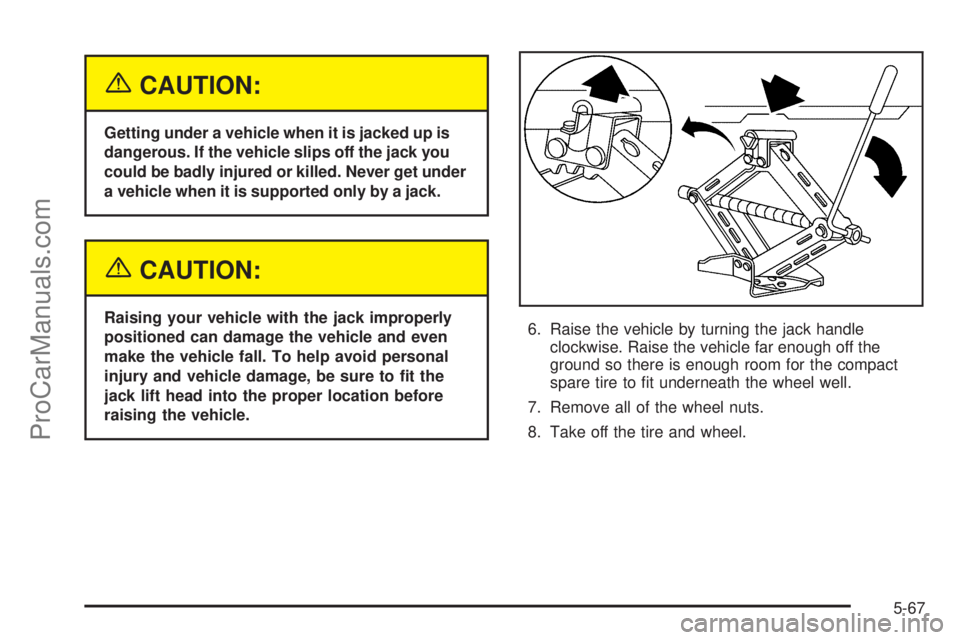SATURN L-SERIES 2005 Owners Manual
Manufacturer: SATURN, Model Year: 2005, Model line: L-SERIES, Model: SATURN L-SERIES 2005Pages: 330, PDF Size: 2.4 MB
Page 261 of 330

Used Replacement Wheels
{CAUTION:
Putting a used wheel on your vehicle is
dangerous. You can’t know how it’s been used
or how far it’s been driven. It could fail
suddenly and cause a crash. If you have to
replace a wheel, use a new Saturn original
equipment wheel.
Tire Chains
{CAUTION:
Don’t use tire chains. There’s not enough
clearance. Tire chains used on a vehicle
without the proper amount of clearance can
cause damage to the brakes, suspension or
other vehicle parts. The area damaged by the
tire chains could cause you to lose control of
your vehicle and you or others may be injured
in a crash.
Use another type of traction device only if its
manufacturer recommends it for use on your
vehicle and tire size combination and road
conditions. Follow that manufacturer’s
instructions. To help avoid damage to your
vehicle, drive slowly, readjust or remove the
device if it’s contacting your vehicle, and
don’t spin your wheels. If you do �nd traction
devices that will �t, install them on the
front tires.
5-61
ProCarManuals.com
Page 262 of 330

If a Tire Goes Flat
It’s unusual for a tire to “blowout” while you’re driving,
especially if you maintain your tires properly. If air goes
out of a tire, it’s much more likely to leak out slowly.
But if you should ever have a “blowout,” here are a
few tips about what to expect and what to do:
If a front tire fails, the flat tire will create a drag that
pulls the vehicle toward that side. Take your foot off the
accelerator pedal and grip the steering wheel firmly.
Steer to maintain lane position, and then gently brake
to a stop well out of the traffic lane.
A rear blowout, particularly on a curve, acts much like
a skid and may require the same correction you’d use in
a skid. In any rear blowout, remove your foot from the
accelerator pedal. Get the vehicle under control by
steering the way you want the vehicle to go. It may be
very bumpy and noisy, but you can still steer. Gently
brake to a stop, well off the road if possible.{CAUTION:
Lifting a vehicle and getting under it to do
maintenance or repairs is dangerous without
the appropriate safety equipment and training.
The jack provided with your vehicle is designed
only for changing a �at tire. If it is used for
anything else, you or others could be badly
injured or killed if the vehicle slips off the jack.
Use the jack provided with your vehicle only for
changing a �at tire.
If a tire goes flat, the next part shows how to use your
jacking equipment to change a flat tire safely.
Changing a Flat Tire
If a tire goes flat, avoid further tire and wheel damage
by driving slowly to a level place. Turn on your
hazard warning flashers.
5-62
ProCarManuals.com
Page 263 of 330

{CAUTION:
Changing a tire can be dangerous. The vehicle
can slip off the jack and roll over or fall on you
or other people. You and they could be badly
injured or even killed. Find a level place to
change your tire. To help prevent the vehicle
from moving:
1. Set the parking brake �rmly.
2. Put the shift lever in PARK (P).
3. Turn off the engine and do not restart
while the vehicle is raised.
4. Do not allow passengers to remain in
the vehicle.
To be even more certain the vehicle will not
move, you should put blocks at the front and
rear of the tire farthest away from the one
being changed. That would be the tire, on the
other side, at the opposite end of the vehicle.When you have a flat tire, use the following example as a
guide to assist you in the placement of wheel blocks.
The following information will tell you next how to use
the jack and change a tire.
5-63
ProCarManuals.com
Page 264 of 330

Removing the Spare Tire and Tools
The equipment you’ll need is located in the trunk.
1. Open the jack access door on the left side panel of
the trunk.
2. Remove the nut that holds the jack in place and
remove the jack together with the wheel wrench.3. Lift the trunk liner and place the plastic hook in the
lip of the trunk.
4. Remove the nut that holds down the spare tire.
5. Remove the compact spare tire. SeeCompact
Spare Tire on page 5-72.
6. Remove the wheel wrench from the jack. It is held
in place by two clips which are attached to the jack.
7. Fold out the socket portion of the wrench from the
handle.
5-64
ProCarManuals.com
Page 265 of 330

The tools you’ll be using include the jack (A) and wheel
wrench (B).
Removing the Flat Tire and
Installing the Spare Tire
You must take off the wheel cover or hubcap to reach
the wheel bolts.
For steel wheels with full plastic covers and aluminum
wheels with large circular center caps, do the following:
1. Loosen all five hex-shaped plastic caps by
turning the wrench counterclockwise. Do not try
to remove plastic caps from the cover or center cap.
2. Pull the cover or center cap away from the wheel
and place it in the trunk.
When reinstalling full plastic covers or center caps,
tighten all five plastic caps hand snug with the aid of the
wheel wrench and tighten them with the wheel wrench
an additional one-quarter of a turn.
Once the wheel cover is removed, use the following
steps to remove the flat tire and install the spare tire.
1. Use the wheel wrench to loosen all the wheel nuts.
Don’t remove them yet.
5-65
ProCarManuals.com
Page 266 of 330

2. Attach the wheel wrench to the jack bolt head and
rotate the wheel wrench clockwise. That will raise
the lift head a little.3. Locate the jack notches (A and B) in the vehicle’s
frame.
4. Position the jack in the notch near the tire being
changed, but make sure all of the jack lift head
is touching the jacking flange under the body.
Do not place the jack under a body panel.
5. Put the compact spare tire near you.
5-66
ProCarManuals.com
Page 267 of 330

{CAUTION:
Getting under a vehicle when it is jacked up is
dangerous. If the vehicle slips off the jack you
could be badly injured or killed. Never get under
a vehicle when it is supported only by a jack.
{CAUTION:
Raising your vehicle with the jack improperly
positioned can damage the vehicle and even
make the vehicle fall. To help avoid personal
injury and vehicle damage, be sure to �t the
jack lift head into the proper location before
raising the vehicle.6. Raise the vehicle by turning the jack handle
clockwise. Raise the vehicle far enough off the
ground so there is enough room for the compact
spare tire to fit underneath the wheel well.
7. Remove all of the wheel nuts.
8. Take off the tire and wheel.
5-67
ProCarManuals.com
Page 268 of 330

{CAUTION:
Rust or dirt on the wheel, or on the parts to
which it is fastened, can make the wheel nuts
become loose after a time. The wheel could
come off and cause an accident. When you
change a wheel, remove any rust or dirt from
the places where the wheel attaches to the
vehicle. In an emergency, you can use a cloth
or a paper towel to do this; but be sure to use
a scraper or wire brush later, if you need to,
to get all the rust or dirt off.
{CAUTION:
Never use oil or grease on studs or nuts. If
you do, the nuts might come loose. Your wheel
could fall off, causing a serious accident.
5-68
ProCarManuals.com
Page 269 of 330

9. Remove any rust or dirt
from the wheel bolts,
mounting surfaces
and spare wheel.
10. Place the compact spare tire on the wheel-mounting
surface.
11. Reinstall the wheel nuts. Tighten each nut by hand
until the wheel is held against the hub.12. Lower the vehicle by turning the jack handle
counterclockwise.
5-69
ProCarManuals.com
Page 270 of 330

{CAUTION:
Incorrect wheel nuts or improperly tightened
wheel nuts can cause the wheel to come loose
and even come off. This could lead to an
accident. Be sure to use the correct wheel
nuts. If you have to replace them, be sure to
get new GM original equipment wheel nuts.
Stop somewhere as soon as you can and have
the nuts tightened with a torque wrench to the
proper torque speci�cation. SeeCapacities
and Specifications on page 5-89for wheel nut
torque speci�cation.
Notice:Improperly tightened wheel nuts can lead
to brake pulsation and rotor damage. To avoid
expensive brake repairs, evenly tighten the wheel
nuts in the proper sequence and to the proper
torque speci�cation. SeeCapacities and
Specifications on page 5-89for the wheel nut torque
speci�cation.13. Tighten the wheel nuts
firmly in a crisscross
sequence, as shown.
14. Lower the jack all the way and remove the jack
from under the vehicle.
15. Tighten the bolts firmly with the wheel wrench.
Notice:Wheel covers will not �t on your compact
spare. If you try to put a wheel cover on the compact
spare, you could damage the cover or the spare.
Do not try to put a wheel cover on your compact spare
tire. It will not fit. Store the wheel cover in the trunk
until you have the flat tire repaired or replaced.
5-70
ProCarManuals.com